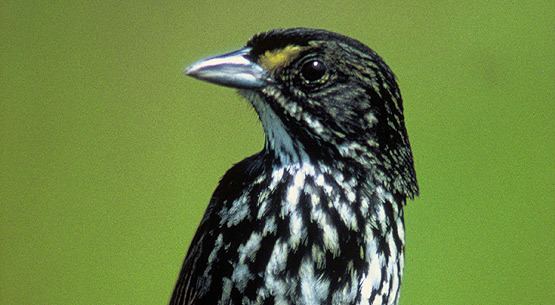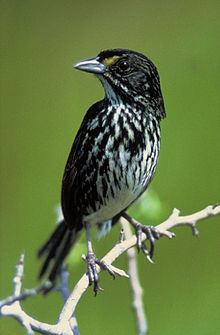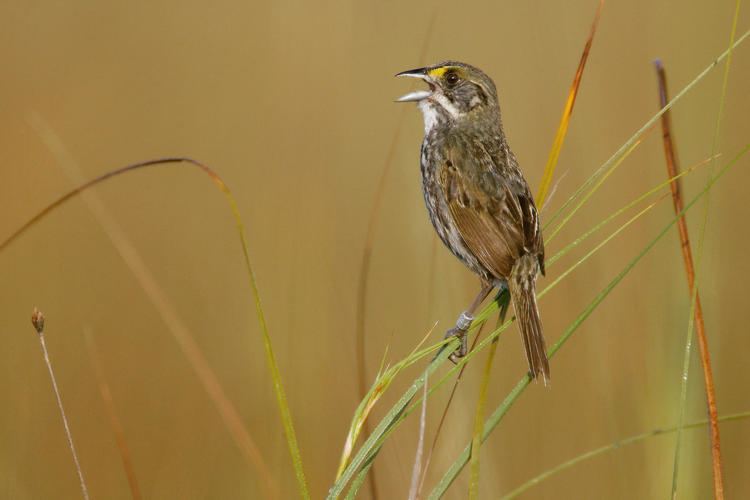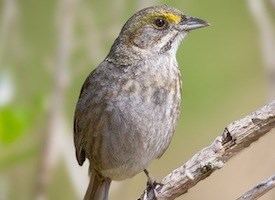Genus Ammodramus Higher classification Seaside sparrow Order Passerine | Family Emberizidae Phylum Chordata Rank Subspecies | |
 | ||
Scientific name Ammodramus maritimus nigrescens Similar Seaside sparrow, Bird, Ammodramus, Cape Sable seaside s, Heath hen | ||
Dusky seaside sparrow
The dusky seaside sparrow, Ammodramus maritimus nigrescens, was a non-migratory subspecies of the seaside sparrow, found in Florida in the natural salt marshes of Merritt Island and along the St. Johns River. The last definite known individual died on June 17, 1987, and the subspecies was officially declared extinct in December 1990.
Contents
- Dusky seaside sparrow
- Dusky seaside sparrow miami from the arlington show
- Origin
- Species divergence
- Causes for extinction
- Last specimens
- References

Dusky seaside sparrow miami from the arlington show
Origin

The dusky seaside sparrow was first categorized as a species in 1873, after its discovery on March 17, 1872 by Charles Johnson Maynard. Its dark coloration and distinct song are what separates it as a subspecies of other seaside sparrows. Found in the marshes of Florida's Atlantic Coast on Merrit Island and the upper St. Johns River, the dusky seaside sparrow was geologically isolated from other seaside sparrows (Hill 239). it was categorized as a subspecies in 1973. Even though the dusky's mitochondrial DNA is the same as the mitochondrial DNA of other seaside sparrow populations, DNA testing by itself does not demonstrate that its subspecies classification is undeserving (Hill 239). In 1981, only five dusky seaside sparrows remained, all being males. Conservation efforts were made by trying to breed the remaining duskies with Scott's seaside sparrows in order to create half dusky hybrid offspring. "Unfortunately, although the Fish and Wildlife Service initially supported the crossbreeding program, it withdrew its support due to Interior's hybrid policy" (Hill 239). Due to only the males being left, even though duskies could be crossbred with other seaside sparrows, there would never be another pure dusky seaside sparrow again.
Species divergence

Based on comparisons between mtDNA of the dusky seaside sparrow and its close relative, Scott's seaside sparrow, John Avise and William Nelson were able to estimate the last time that the dusky sparrow and the seaside sparrow came in contact. Since it has been established that the dusky sparrow had a very small inhabited locale, it was isolated from other sparrows for a very long time. Assuming that the mtDNA in sparrows evolves at the rate which is estimated for mammals and other birds (approximately 2-4% every million years), then the last time the dusky sparrow was in contact with Scott's seaside sparrow was approximately 250,000-500,000 years ago, giving plenty of time for the dusky sparrow to establish differences between other varieties of species, such as its unique plumage and call.[1]
Causes for extinction

When Merritt Island was flooded with the goal of reducing the mosquito population around the Kennedy Space Center, the sparrows' nesting grounds were devastated, and their numbers plummeted. Later, the marshes surrounding the river were drained, to facilitate highway construction; this was a further blow. Eventually, pollution and pesticides took such a high toll that by 1979, only six dusky seaside sparrows were known to exist — all of whom were males; a female was last sighted in 1975.
Last specimens
Captive breeding of all remaining dusky seaside sparrows with the Scott's seaside sparrow (A. m. peninsulae) from Florida's gulf coast was approved in 1979. By 1980 five dusky seaside sparrows were in a captive breeding facility in Gainesville, Florida. One, banded in 1978 with an orange leg band was unique.
"Orange Band" was left by himself on the St. Johns Unit of the St. Johns NWR after a yellow-leg-banded dusky was captured in 1979. Field observations of color banded sparrows from 1975 to 1979 indicated that dusky seaside sparrows seldom traveled more than a mile or two in their lifetimes. In April 1980, "Orange Band" was again observed on the St. Johns Unit, but was surprisingly captured in June eight miles south on the Beeline Unit in the company of a dusky with a green leg band. Before finding "Green Band", "Orange Band" passed the general vicinity of the two unbanded dusky seaside sparrows.
In 1983 the last four living dusky seaside sparrows were taken to the Walt Disney World Resort, to continue crossbreeding and living out their days in a protected habitat on the Discovery Island nature reserve. By March 31, 1986, only "Orange Band" remained.
Despite being blind in one eye, "Orange Band" reached extreme old age for a sparrow, living at least nine years, and possibly as many as thirteen, before dying on June 17, 1987.
After the death of the final "pure" dusky sparrow, the breeding program was discontinued due to the fact that it was thought the hybrids that exist could not reproduce to create dusky sparrows, since they did not share the proper mtDNA that dusky sparrows possess. However, research done on a similar species known as Passerella iliaca, or the fox sparrow, was able to show that some subspecies of one plumage group had the plumage of another despite having the "wrong" mtDNA type. This potentially meant that if the breeding program was continued with the dusky sparrow hybrids, sparrows with the same color plumage as the dusky sparrows would eventually be produced. Unfortunately, shortly after the breeding program was halted, the remaining hybrid sparrows either died or escaped captivity, leading to the final extinction of the taxon.
"Green Band" proved elusive, and was never recaptured after having been banded. He was last seen on July 23, 1980.
